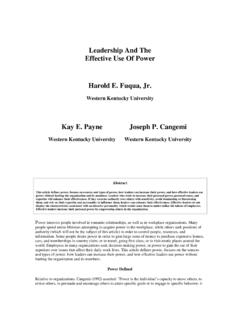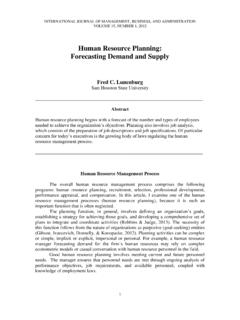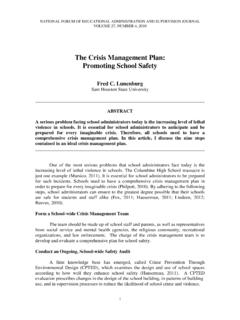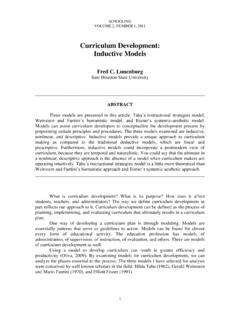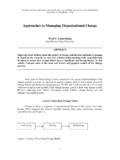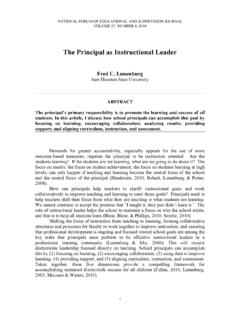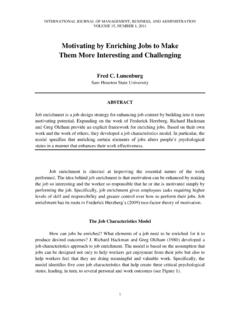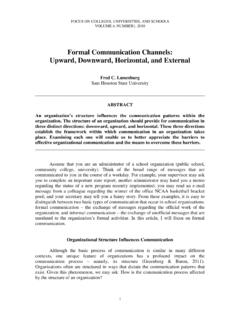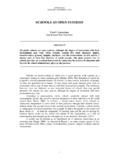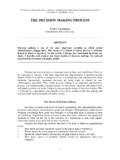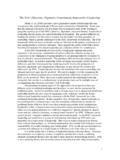Transcription of Leader-Member Exchange Theory: Another Perspective on …
1 INTERNATIONAL JOURNAL OF MANAGEMENT, BUSINESS, AND ADMINISTRATION VOLUME 13, NUMBER 1, 2010 1 Leader-Member Exchange theory : Another Perspective on the leadership Process Fred C. Lunenburg Sam Houston State University _____ ABSTRACT The basic idea behind the Leader-Member Exchange (LMX) theory is that leaders form two groups, an in-group and an out-group, of followers. In-group members are given greater responsibilities, more rewards, and more attention. The leader allows these members some latitude in their roles. They work within the leader s inner circle of communication.
2 In contrast, out-group members are outside the leader s inner circle, receive less attention and fewer rewards, and are managed by formal rules and policies. In this article, I discuss how the Leader-Member Exchange theory works; research findings; managerial implications of the theory ; and how to build high-quality Leader-Member Exchange relationships with all employees. _____ Many theories of leadership assume that the superior behaves in essentially the same manner toward all members of his or her work group. In fact, however, leaders often act very differently toward different subordinates, and develop contrasting kinds of relationships with them.
3 This Perspective on the leadership process is provided by the Leader-Member Exchange theory (LMX) (Graen & Uhl-Bien, 1995). How the Leader-Member Exchange theory Works The LMX theory focuses on a dyad, that is, the relationship between a leader and each subordinate considered independently, rather than on the relationship between the superior and the group. Each linkage, or relationship, is likely to differ in quality. Thus, the same leader may have poor interpersonal relations with some subordinates and open and trusting relations with others.
4 The relationships within these pairings, or dyads, may be of a predominantly in-group or out-group nature. A leader initiates either an in-group or an out-group Exchange with a member of the organization early in the life of the dyadic relationship. Members of the in-group are invited to participate in decision making and are given added responsibility. The leader allows these members some latitude in their roles; in effect, the leader and key INTERNATIONAL JOURNAL OF MANAGEMENT, BUSINESS, AND ADMINISTRATION 2_____ subordinates negotiate the latter s responsibilities in a non-contractual Exchange relationship.
5 In essence, an in-group member is elevated to the unofficial role of trusted lieutenant. In-group members, in many respects, enjoy the benefits of job latitude (influence in decision making, open communications, and confidence in and consideration for the member). The subordinate typically reciprocates with greater than required expenditures of time and effort, the assumption of greater responsibility, and commitment to the success of the organization. In contrast, members of the out-group are supervised within the narrow limits of their formal employment contract.
6 Authority is legitimated by the implicit contract between the member and the organization. The leader will provide support, consideration, and assistance mandated by duty but will not go beyond such limits. In effect, the leader is practicing a contractual Exchange with such members; they are hired hands, who are being influenced by legitimate authority rather than true leadership . In return, out-group members will do what they have to do and little beyond that. Research Findings Research on the LMX theory is supportive. Specifically, the research supporting the LMX theory indicates that leaders do differentiate among followers and that these differences are not random.
7 Followers exhibiting higher levels of self-efficacy were more likely to form in-group relationships with leaders, who perceived the followers to be more likable and to be more similar in personality to the leader (Murphy & Ensher, 1999). Furthermore, perceived similarities between the leader and the follower, implicit theories, and self-schemas led to greater liking of subordinates and higher quality Leader-Member exchanges (Engle & Lord, 1997). The perception of similarity seems to be a more important factor than the actual demographic similarities (age, gender, ethnicity) (Murphy & Ensher, 1999).
8 Research further suggests that a sharp distinction between the in-group and the out-group may not be desirable, because subordinates in the out-group might resent their relatively inferior status and differential treatment (McClane, 1991; Yukl, 2010). There is evidence that members of the in-group (those who report a high-quality relationship with the leader) assume greater job responsibility, contribute more to the organization, and are rated higher in performance than members of the out-group (those who report a low-quality relationship with the leader) (Schreisheim, Neider, & Scandura, 1998).
9 And, the type of stress varies by the group to which a subordinate belongs. In-group members stress emanates from the additional responsibilities given to them by the leader, whereas out-group members stress emanates from being left out of the communication loop (Nelson, Basu, & Purdie, 1998). Results from a recent meta-analysis of 50 studies involving 9,324 subjects revealed a moderately strong, positive relationship between subordinates with in-group status and engagement in more helping or citizenship behaviors at work (Ilies, Nahrgang, & Morgeson, 2007).
10 In Another study, followers with in-group status with their leaders had higher performance ratings and reported greater satisfaction with the leader (Chen, Lamb, & Zhong, 2007). These positive research findings for in-group members FRED C. LUNENBURG _____3 should not be surprising, considering our knowledge of the self-fulfilling prophesy. Leaders invest their resources in those they expect to perform well. Moreover, leaders believe that in-group members are the most competent and, therefore, they treat them as such fulfilling the self-fulfilling prophesy (Eden, 1992).
